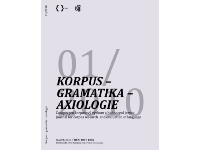Několik poznámek k synonymii a frekvenci příčinných spojek
Some notes on the synonymy and frequency of causal conjunctions
Author(s): František ŠtíchaSubject(s): Theoretical Linguistics
Published by: AV ČR - Akademie věd České republiky - Ústav pro jazyk český
Keywords: causal conjunctions; synonymy; idiolectical use; style
Summary/Abstract: In Czech, five synonymous causal conjunctions (protože, neboť, jelikož, poněvadž, ježto) – corresponding to the English because – are used. These five causal conjunctions differ in style and in frequency of use. Four of them (neboť, jelikož, poněvadž, ježto) are stylistically marked and only protože is stylistically unmarked and consequently used more frequently. Until now, Czech grammarians have labeled neboť a coordinative conjunction and separated it from the other four ones in explaining causal relations in complex sentences. In fact, the five conjunctions have the same function to express a causal relation, except for neboť being positionally restricted to postposition. In this paper, I argue that whenever the conjunction neboť is used in a text it is synonymous with the other causal conjunctions. Therefore, this separation of neboť from protože, jelikož, poněvadž, ježto in grammar descriptions does not correspond to the function of these conjunctions. So far, neboť has been the second most frequent causal conjunction and together with protože used more frequently than the remaining three conjunctions. This article focuses on the idiolectical use of only one or two of the five causal conjunctions. Some Czech authors and translators into Czech mainly or solely use only one or two of all causal conjunctions and neglect the others. What is unpredictable and strange is that sometimes the less frequent conjunctions poněvadž and jelikož are strongly preferred.
Journal: Korpus - gramatika - axiologie
- Issue Year: 2018
- Issue No: 17
- Page Range: 57-65
- Page Count: 9
- Language: Czech

